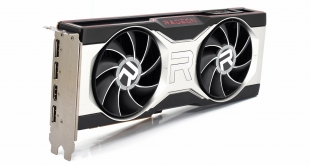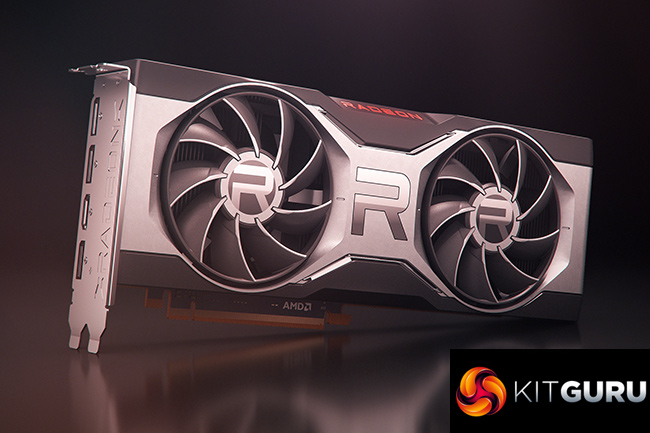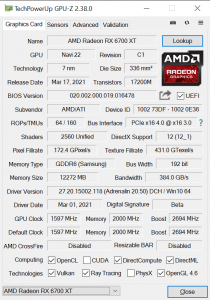
Heralded as the ultimate GPU for 1440p gaming, today we are putting AMD's RX 6700 XT through its paces. As the fourth RDNA 2-based GPU to hit the market, the RX 6700 XT is also the cheapest with an MSRP of £419.99/$479, putting it head to head with Nvidia's RTX 3070 and RTX 3060 Ti graphics cards. Let's see how AMD's Navi 22 silicon can compare to its Ampere-based rivals.
As we alluded to, AMD's RX 6700 XT is built on a completely new GPU. So far, all the RDNA 2 GPUs we have seen – the RX 6900 XT, RX 6800 XT and RX 6800 – use the same Navi 21 GPU, but with slightly differing configurations of that GPU. With the RX 6700 XT, AMD has debuted its smaller Navi 22 GPU, which offers 40 Compute Units when fully populated.
Compared to the RX 6800, the RX 6700 XT sports 33% fewer cores, which would suggest a fairly large gap in performance between the two. AMD has also significantly increased clock speeds with the 6700 XT, however, with its rated game clock over 600MHz faster than its bigger brother. We test this new GPU in 12 games to see exactly how it stacks up against the RX 6800, and also Nvidia's RTX 3070 and RTX 3060 Ti.
| RX 6900 XT | RX 6800 XT | RX 6800 | RX 6700 XT | RX 5700 XT | |
| Architecture | RDNA 2 | RDNA 2 | RDNA 2 | RDNA 2 | RDNA |
| Manufacturing Process | 7nm | 7nm | 7nm | 7nm | 7nm |
| Transistor Count | 26.8 billion | 26.8 billion | 26.8 billion | 17.2 billion | 10.3 billion |
| Die Size | 519 mm² | 519 mm² | 519 mm² | 336 mm² | 251 mm² |
| Ray Accelerators | 80 | 72 | 60 | 40 | n/a |
| Compute Units | 80 | 72 | 60 | 40 | 40 |
| Stream Processors | 5120 | 4608 | 3840 | 2560 | 2560 |
| Game GPU Clock | Up to 2015MHz | Up to 2015MHz | Up to 1815MHz | Up to 2424MHz | Up to 1755MHz |
| Boost GPU Clock | Up to 2250MHz | Up to 2250MHz | Up to 2105MHz | Up to 2581MHz | Up to 1905MHz |
| Peak SP Performance | Up to 23.04 TFLOPS | Up to 20.74 TFLOPS | Up to 16.17 TFLOPS | Up to 13.21 TFLOPS | Up to 9.75 TFLOPS |
| Peak Half Precision Performance | Up to 46.08 TFLOPS | Up to 41.47 TFLOPS | Up to 32.33 TFLOPS | Up to 26.43 TFLOPS | Up to 19.5 TFLOPS |
| Peak Texture Fill-Rate | Up to 720 GT/s | Up to 648.0 GT/s | Up to 505.2 GT/s | Up to 413.0 GT/s | Up to 304.8 GT/s |
| ROPs | 128 | 128 | 96 | 64 | 64 |
| Peak Pixel Fill-Rate | Up to 288.0 GP/s | Up to 288.0 GP/s | Up to 202.1 GP/s | Up to 165.2 GP/s | Up to 121.9 GP/s |
| AMD Infinity Cache | 128MB | 128MB | 128MB | 96MB | n/a |
| Memory | 16GB GDDR6 | 16GB GDDR6 | 16GB GDDR6 | 12GB GDDR6 | 8GB GDDR6 |
| Memory Bandwidth | 512 GB/s | 512 GB/s | 512 GB/s | 384 GB/s | 448 GB/s |
| Memory Interface | 256-bit | 256-bit | 256-bit | 192-bit | 256-bit |
| Board Power | 300W | 300W | 250W | 230W | 225W |
As a spec recap, RX 6700 XT is built using the Navi 22 GPU, a physically smaller die than Navi 21, measuring 336 mm². It houses 40 Compute Units (CUs), with 64 stream processors per CU, giving a total of 2560. RX 6700 XT features a fully populated Navi 22 GPU, but we can expect cut-down versions to appear with the RX 6700, and potentially RX 6600 XT if that comes to market.
RDNA 2 houses one ray accelerator per CU, so there's a total of 40 with the RX 6700 XT. Four texture units per CU gives a total of 160, while there's also 64 ROPs. Clock speed sees a significant bump, even when compared to the RX 6800 series, with a rated game clock of 2424MHz, compared to 1815MHz for the RX 6800.
As for the memory configuration, AMD has opted to use a 192-bit memory interface paired with 12GB of GDDR6 memory. Using 16Gbps modules, total memory bandwidth hits 384 GB/s, which is lower than its predecessor, the RX 5700 XT. RDNA 2 GPUs, however, have the benefit of AMD's Infinity Cache, with a 96MB cache used here.
Lastly, total board power (TBP) is rated at 230W, which is an 8% reduction compared to the 250W RX 6800. We test this later in the review, while also looking at overall efficiency of the graphics card.
 KitGuru KitGuru.net – Tech News | Hardware News | Hardware Reviews | IOS | Mobile | Gaming | Graphics Cards
KitGuru KitGuru.net – Tech News | Hardware News | Hardware Reviews | IOS | Mobile | Gaming | Graphics Cards




